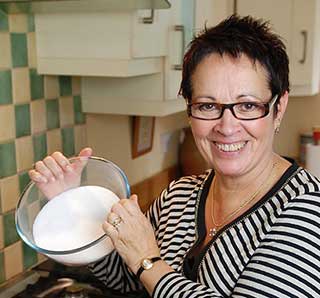
What is jam? “A preserve made from whole fruit boiled to a pulp with sugar.” Lots of opportunities to quibble with that, most especially, if you’re planning to sell the stuff in the UK and label it “jam,” the precise amount of sugar. More than 60% and you’re fine calling it jam. Less than 50% and you need to call it reduced-sugar jam. Lower still, and it becomes a fruit spread. All that is about to change though, thanks to a UK Goverment regulation that will allow products with less than 60% sugar to be labelled jam.
There’s nothing like a threat to the traditional British way of life to motivate the masses, although as an expat, I had no idea of the kerfuffle this had raised until I read about it on the website of the Campaign for Real Farming.
Podcast: Play in new window | Download (Duration: 12:29 — 11.5MB)
Subscribe: Google Podcasts | Spotify | Android | RSS | More
Changing the rules for what is labelled jam may seem like a tempest on a teacake, but it is symptomatic of the growing distance between what were once simple methods of food processing – in this case to preserve it – and the industrial version of a similar product. And making jam at home isn’t that hard.
There is, though, the problem of getting it to set properly. I had a little read to remind myself of what Vivien Lloyd called the magic of pectin, and it isn’t simple. Pectin is a long string of a molecule, present in the glue that cements cell walls together. Some fruits have loads of it, others less. The long strings bind together and form a mesh that traps any liquid inside the spaces between the pectin molecules, but they bind together only under specialised conditions. Acid reduces the tendency for pectin molecules to repel one another, while sugar attracts water, and so allows the pectin molecules to come together. And fruits supply acid and and sugar. “Sounds like a cinch,” says Harold McGee …
“But as anyone who has tried knows, it’s anything but a cinch. Making preserves is a tricky business because the necessary balance between pectin, acid, and sugar is a very delicate one. Food scientists have found that a pH between 2.8 and 3.4, a pectin concentration of 0.5 to 1.0%, and a sugar concentration of 60 to 65% are generally optimal, but you would have to be cooking in a well-equipped laboratory to measure the first two condition (sugar content is easily measure by boiling point).”
That’s one reason I asked Vivien Lloyd to share her recipe for raspberry jam, which she kindly did. Download the recipe for Raspberry and Vanilla Jam.
Notes
- More science of pectin.
- Photo of Vivien Lloyd by Robert Walster.
- Music – in and out – was, of course, Strawberry Jam, by Michelle Shocked. And no, I don’t understand what she’s been saying lately; this is not an endoresement of any kind, it is just good music.
- I make good jam.
Jam tomorrow? by Jeremy Cherfas (Eat This Podcast)
If possible, click to play, otherwise your browser may be unable to play this audio file.
I realize that I’m probably ruined by eating soft set American jams and jellies all my life, aside from a half a dozen or so homemade versions I’ve made myself over the years. Here in the states, we’ve slipped even further–most jams are comprised of high fructose corn syrup instead of sugar. If only that revolution had happened after the 1920s instead of the 1770s perhaps things would be different.
I’m curious what’s become of this issue four years on? Did the “hard”-liners win out, or did the regulations turn to (soft set) jelly?
Syndicated copies to:
Related
Author: Chris Aldrich
I’m a biomedical and electrical engineer with interests in information theory, complexity, evolution, genetics, signal processing, theoretical mathematics, and big history.
I’m also a talent manager-producer-publisher in the entertainment industry with expertise in representation, distribution, finance, production, content delivery, and new media.
View all posts by Chris Aldrich
[…] can hear Vivien Lloyd and myself talking to Jeremy Chefas about this subject on the Eat This […]